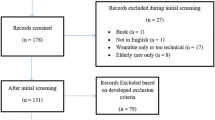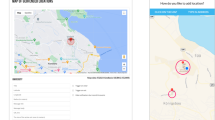Abstract
Mobile devices are equipped with increasing processing power and sensing capabilities, and mobile services can benefit from these features to provide a more personalized and context-aware experience to final users. To efficiently collect and deliver context information, a proper architecture is required, where heterogeneous context information can be processed to provide higher-level context information, context data are represented uniformly, and applications can process context data with high-level queries. This paper fulfils this goal of interoperability and domain independence by defining a framework for context data management relying on open standards (XMPP and REST), acting as an enabler for third-party context-aware applications; other main novelties of our work are the definition of a ContextML for standard context data representation, and a Context Query Language (CQL) to access context information based on high-level data filtering.
Similar content being viewed by others
References
Licciardi CA, Falcarin P (2003) Analysis of NGN service creation technologies. IEC Annu Rev Commun 56: 537–551
Sheng QZ, Yu J, Del Alamo JM, Falcarin P (2009) Personalized service creation and provision for the mobile web. In: King I, Baeza-Yates R (eds) Weaving services, location, and people on world wide web. Springer, pp 99–121. ISBN: 978-3-642-00569-5
Dey AK (2001) Understanding and using context. Pers Ubiquitous Comput J 5(1): 4–7
Goix LW, Valla M, Cerami L, Falcarin P (2007) Situation inference for mobile users: a rule based approach. In: IEEE international workshop on managing context information and semantics in mobile environments (MCISME-2007)
Falcarin P, Vetrò A, Yu J, Islam S (2011) A recommender system for telecom users: experimental evaluation of recommendation algorithms. In: IEEE 10th international cybernetic intelligent systems (CIS), London
Kapitsaki GM, Prezerakos GN, Tselikas ND, Venieris IS (2009) Context-aware service engineering: a survey. Elsevier J Syst Softw 82(8): 1285–1297
Truong HL, Dustdar S (2009) A survey on context-aware web service systems. IJWIS 5(1): 5–31
OASIS web services notification (WSN) TC. Online http://www.oasisopen.org/committees/tchome.php?wgabbrev=wsn
Knappmeyer M, Kiani SL, Frà C, Moltchanov B, Baker N (2010) ContextML: a light-weight context representation and context management schema. In: 5th IEEE international symposium on wireless pervasive computing (ISWPC), pp 367–372
Reichle R (2008) A context query language for pervasive computing environments. In: 6th IEEE international conference on pervasive computing and communications. IEEE CS Press, pp 434–440
Context Representation and Management Language. ContextML and CQL XML schemas. On-line at: http://contextml.tilab.com
Raento M, Oulasvirta A, Petit R, Toivonen H (2005) ContextPhone: a prototyping platform for context-aware mobile applications. IEEE Pervasive Comput 4(2): 51–59
WAP-FORUM. User agent profile (uaprof). http://www.wapforum.org
Costabello L, Rodriguez Rocha O, Goix LW (2008) Sharing mobile user experiences with context-based mashups. In: Proceedings of the 5th Annual international conference on mobile and ubiquitous systems: computing, networking, and services. ICST Brussels (Belgium). ISBN: 978-963-9799-27-1. doi:10.4108/ICST.MOBIQUITOUS2008.3978
Lamorte L (2007) A platform for enabling context aware telecommunication services. In: Context awareness for proactive systems (CAPS) workshop, Guildford, UK
Haghighi PD, Zaslavsky A, Krishnaswamy S (2006) An evaluation of query languages for context-aware computing. In: 17th international conference on database and expert systems applications (DEXA). Springer, Heidelberg, pp 455–462
Paspallis N (2008) A pluggable and reconfigurable architecture for a context-aware enabling middleware system. In: 10th international symposium on distributed objects, middleware, and applications (DOA’08), LNCS, vol 5331. Springer, Heidelberg, pp 553–570
RFC 3921—eXtensible Messaging and Presence Protocol (XMPP): instant messaging and presence. http://tools.ietf.org/html/rfc3921
Gomes D, Goncalvesy JM, Otero Santosy R, Aguiar R (2010) XMPP based context management architecture. In: IEEE Globecom 2010
SOAP specification. Online at: http://www.w3.org/TR/soap/
C-CAST project deliverable. On-line: http://www.ict-ccast.eu/files/C-Cast_D16_revised.pdf
Dey AK, Abowd GD, Salber D (2001) A conceptual framework and a toolkit for supporting the rapid prototyping of context-aware applications. Hum Comput Interact 16: 97–166
Roman M, Hess C, Cerqueira R, Campbell RH (2002) A middleware infrastructure for active spaces. IEEE Pervasive Comput 1(4): 74–83
Strang T, Popien CL (2004) A context modeling survey. In: ACM workshop on advanced context modelling, reasoning and management, co-located with UbiComp-2004
Yu J, Sheng QZ, Liao K, Wong HS (2010) Model-driven development of context-aware web services. In: Enabling context-aware web services, methods, architectures and technologies. CRC Press, Boca Raton, pp 31–46
Otzturk P, Aamodt A (1997) Towards a model of context for case-based diagnostic problem solving. In: Proceedings of CONTEXT-97, pp 198–208
Wang XH, Zhang DQ, Gu T, Pung HK (2004) Ontology based context modeling and reasoning using OWL. In: Proceedings of the 2nd IEEE conference on pervasive computing and communications workshops (PERCOMW04), IEEE
CCPP. Composite capabilities / preferences profile (cc/pp). http://www.w3.org/Mobile/CCPP
Hong JI, Landay JA (2004) Architecture for privacy-sensitive ubiquitous computing. In: Proceedings of the 2nd international conference on mobile systems, applications, and services (MobiSys 2004), ACM, pp 177–189
Strohbach M, Bauer M, Kovacs E, Villalonga C, Richter N (2007) Context sessions—a novel approach for scalable context management in NGN networks. In: MNCNA’07 proceedings of the workshop on middleware for next-generation converged networks and applications, ACM
Jaroucheh Z, Liu X, Smith S (2011) An approach to domain-based scalable context management architecture in pervasive environments. Pers Ubiquitous Comput 1617–4909:1–15
Henricksen K, Indulska J, McFadden T, Balasubramaniam S (2005) Middleware for distributed context-aware systems. In: International symposium on distributed objects and applications. Springer, Heidelberg, pp 846–863
Grossmann M (2005) Efficiently managing context information for large-scale scenarios. In: 3rd IEEE international conference on pervasive computing and communications (PerCom-05), IEEE, pp 331–340
Dearle A, Kirby G, Morrison R, McCarthy A, Mullen K, Yang Y, Connor R, Welen P, Wilson A (2003) Architectural support for global smart spaces. In: Proceedings of the 4th international conference on mobile data management (MDM-03), LNCS, vol 2574. Springer, Heidelberg, pp 153–164
Lee D, Meier R (2009) A hybrid approach to context modelling in large-scale pervasive computing environments. In: Proceedings of the fourth international ICST conference on communication system software and middleware (COMSWARE’09)
Castelli G, Zambonelli F (2009) Contextual data management and retrieval: a self-organized approach. In: Proceedings of IEEE/WIC/ACM international conference on web intelligence and intelligent agent technology, pp 535–538
Bettini C,Maggiorini D,Riboni D (2007) Distributed contextmonitoring for the adaptation of continuous services.World WideWeb J 10(4):503–528
Falcarin P, Venezia C (2008) Communication web services and JAIN-SLEE integration challenges. Int J Web Serv Res IGI-Global 5(4): 59–78
Mejia Bernal JF, Ardito L, Morisio M, Falcarin P (2010) Towards an efficient context-aware system: problems and suggestions to reduce energy consumption in mobile devices. In: IEEE international conference on mobile business (ICMB-10)
Author information
Authors and Affiliations
Corresponding author
Rights and permissions
About this article
Cite this article
Falcarin, P., Valla, M., Yu, J. et al. Context data management: an architectural framework for context-aware services. SOCA 7, 151–168 (2013). https://doi.org/10.1007/s11761-012-0115-1
Received:
Revised:
Accepted:
Published:
Issue Date:
DOI: https://doi.org/10.1007/s11761-012-0115-1




